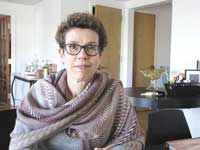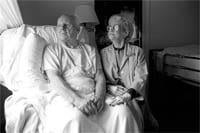It’s Not a Stretch – Cancer Patients, Survivors Are Discovering the Benefits of Yoga
After being diagnosed with breast cancer 11 years ago, Tina Stevens underwent a bilateral mastectomy and reconstructive surgery.
“From that, I lost a lot of arm strength, and my front muscles were really tight,” she told HCN. “I wasn’t sent to physical therapy or anything. A couple of years went by, and I said, ‘I need to be stronger than this.’ And I would drive by this yoga center thinking, ‘maybe yoga would help.’”
Though intrigued, she was reluctant to try it, but walked in on a free introductory Saturday session. “I really liked it,” said Stevens, who owns the Westfield-based advertising agency Stevens 470. “Over time, yoga really did help a great deal. I got back my arm strength and my flexibility, stretching out muscles that were tight. Honestly, 11 years later, I’m probably stronger than I was before my diagnosis.”
She was so taken with the effects of yoga on her mind and body that she signed up for a teacher-training program at the studio, which specialized in Hatha yoga. She has since become certified to teach Hatha yoga, as well as Yoga for Cancer through a program with Tari Prinster at Kripalu, aiming programs at cancer survivors and the general public alike. Prinster, a 15-year breast-cancer survivor who has written extensively about the benefits of yoga for women like her, has trained more than 1,000 yoga teachers and worked with thousands of survivors.
“As I was doing yoga, I realized some internal healing needed to take place after having cancer,” Stevens said. “I was running my business after surgery; I needed to come back to my life. When you’ve had cancer, you’re kind of always a patient, always in that world. I find the long-term practice of yoga has really helped with that.”
Pam Roberts has a similar story. Following her 1993 diagnosis with breast cancer, she became involved in writing as a form of therapy, starting with her participation in a weekly writing workshop in Shelburne Falls. She found that, no matter what prompt the moderator gave, she wrote about her experience with breast cancer, which necessitated a mastectomy, chemotherapy, and other life-changing treatments.
The workshop proved to be a healing experience for her and inspired her to enroll in the IM School of Healing Arts in New York City, which certified her to lead writing workshops for cancer patients, a practice she continues today. But five years ago, she started offering yoga classes as well.
“I had always done a little bit of yoga. In about 1998, I became a more serious yoga student. Realizing the benefits of yoga, and how it felt for myself, I wanted to include it in my programs for people affected by cancer,” said Roberts, who is certified as a Kripalu yoga teacher and also certified in Yoga of the Heart for Cardiac and Cancer Patients.
Her gentle-yoga programs — the next eight-week session takes place Wednesdays from April 29 to June 17 at the YMCA in Greenfield — consist of stretching, strengthening, and breathing and deep-relaxation exercises.
“We’ve had people come right after their diagnosis, but more people come as they’re ending their treatments, and they gradually ease their way into things,” Roberts said, adding that her classes are funded by support from Wheeling for Healing, a fund-raiser for Baystate Franklin Medical Center’s Oncology Department.
Stevens — whose next “Yoga for Cancer Warriors” class runs for six Thursdays, from April 23 to May 28 — credits Prinster with blazing trails in this field. “I have felt the impact in my own body after many surgeries, chemotherapy, and radiation,” Prinster wrote at kripalu.org. “Yoga brings balance and alignment to all body parts and systems: muscles, bones, organs, and the mind. It’s a holistic path to wellness that focuses on interconnection.”
No Pressure
Roberts repeatedly tells potential participants that yoga doesn’t have to be an intimidating experience.
“We start with a brief check-in that lends almost a support-group aspect to this, and lets people in class get to know each other and share what’s going on in terms of treatment,” she told HCN. “Sometimes, if a couple of people have the same issue, then after class they talk with each other about that.”
After that, she went on, “we start out sitting in chairs with some centering and deep-breathing exercises. One of the benefits of the deep breathing is it calms the nervous system; there’s biological evidence that this is true. Then we start with some gentle exercises sitting in the chair, just stretching and warming up the joints. Then we stand and do some strengthening and balancing and stretching poses, then come down to the floor and do some poses there.
“The final part of the class is a guided relaxation,” Roberts explained. “Everyone gets comfortable lying down on the floor — if possible. Everything can be adapted, and they can also participate by sitting in a chair. I lead them deeper and deeper into relaxation, and they find that calm place within, that wellspring of healing energy and reduced stress.”
Stevens also stresses the low-pressure style of her program. “Our goal is to bring you into yoga where you are; we always have people of different levels. You might say, ‘I’m not flexible, so I can’t do yoga.’ But compare it to skiing — you didn’t go to the top of the hill the first day and say, ‘I don’t know why I can’t do that.’ It’s something you practice. And we’re all practicing.”
Even people who, for physical reasons, have to remain in the chair can still practice the breathing, paying attention, and some stretching, she added. “These are things you can practice even if you can’t physically move around.”
It may sound peaceful, even enjoyable. But what, really, are the medical benefits?
Well, one recent study at Ohio State University found that yoga — specifically the breathing and meditation components — can reduce fatigue and inflammation in breast-cancer survivors.
At the end of 12 weeks of yoga classes, according to the Journal of Clinical Oncology, a group of women who had completed breast-cancer treatment, including surgery and radiotherapy, showed an average 57{06cf2b9696b159f874511d23dbc893eb1ac83014175ed30550cfff22781411e5} reduction in fatigue and up to 20{06cf2b9696b159f874511d23dbc893eb1ac83014175ed30550cfff22781411e5} reduction in inflammation, compared with a similar group that had not received yoga instruction.
In addition, Prinster wrote, “yoga strengthens the immune system. The goal of strengthening the immune system is to keep all of the body’s systems working together. It takes a village: failure of any one system threatens the health of the whole community. Cancer therapies that seek to strengthen the immune system are increasingly proving to be helpful in fighting a wide variety of cancers.”
She cited a 2013 Norwegian study that found that regular gentle yoga and meditation had a rapid effect at the genetic level in circulating cancer-fighting immune cells. “Mindfulness meditation also appears to change the brain and immune function in positive ways.”
Those results don’t surprise Stevens. “Your immune system doesn’t have a heart to pump it like the circulatory system. Yoga is the pump. Movement in the muscles helps pump lymphatic fluid through, and when you sweat, a really good sweat, it cleans out the system, which is one of the things you can do to stay healthier,” she said. “Yoga isn’t going to prevent cancer, and it won’t cure cancer, but it’s certainly a tool for keeping your body healthy.”
In this way, the body is detoxified, Prinster said. “Inversions, a fundamental part of a strong yoga practice, utilize movement and body positioning to reverse the effects of gravity on our body, enhancing the process of cardiovascular and lymphatic drainage.”
Stress Test
But that’s not all, Prinster notes. Yoga detoxifies the mind as well and reduces stress in cancer patients — stress that is sometimes compared to what military veterans face. “They are bombarded by frightening information, subjected to invasive procedures, and must endure cold clinics and blank stares.”
She cited a 2009 study targeting the effects of yoga on emotions, which found that more than 50{06cf2b9696b159f874511d23dbc893eb1ac83014175ed30550cfff22781411e5} of subjects reported an increase in positive emotions and a general sense of calmness after a 10-week program in restorative yoga.
That’s important, Stevens noted, at a time when doctors are increasingly promoting the connections between mind and body — and recognizing yoga and other complementary therapies in strengthening those connections.
“Relax the mind, relax the body,” she told HCN. “There’s so much real research around the mind-body connection. Having a serious illness is stressful in itself for cancer patients, but the side effects of their treatment almost always exacerbate the stress.”
Simply put, she went on, “people often don’t know they have cancer, but once they’re diagnosed, well, all of a sudden, they have this life-or-death disease. Then the treatments cause physical stress. Yoga can help alleviate some of that and help you get some strength back. It’s like saying to your body, ‘how are you? I know I’m beating you up, but I’m here for you.’”
A cancer patient’s life, she noted, is literally thrown into chaos, but yoga can help them manage everything that’s going on.
“You’re more high-risk. You have more follow-ups. Over time, it’s always with you,” Stevens said. “Yoga and cancer, for me, have traveled together. They’re very intertwined for me.”
Yoga proponents like Prinster cite other benefits as well, from weight control and body image to pain management and stronger bones — the latter certainly an issue for women as they get older.
But one of the most important benefits might be social, Roberts said. “We form a community in our group. If someone doesn’t show up or had to go back for more treatments, everyone is supportive.”
“I’ve heard women in my class tell me they sleep better,” she went on. “Surgery, radiation, chemotherapy — all that takes so much out of you. Yoga helps with fatigue and increases your sense of well-being and hopefulness.”
Because women tend to seek this type of support more than men, women — breats-cancer patients in particular — make up the vast majority of Roberts’ classes. For them, it’s often a needed oasis in a difficult time. “Some women say, ‘I look forward to this all week; it helps me get through the rest of the week.’”
Stevens also touted the value of a community of like-minded people, adding that participants don’t have to leave what they’ve learned at the door. “All of these things are tools to take with you. You start to notice, ‘I’m hardly breathing. I’m so stressed today. Take some breaths.’ It becomes something you can take out of yoga class into your life.
“I love yoga because it requires so little,” she added. “You don’t need a gym, you don’t need equipment. You just need you, your mat, and your breath. So why isn’t everyone doing it?”
For more information or to sign up for classes, visit redbirdyoga.com for Stevens’ programs or e-mail pamro@aol.com for Roberts’ programs.


